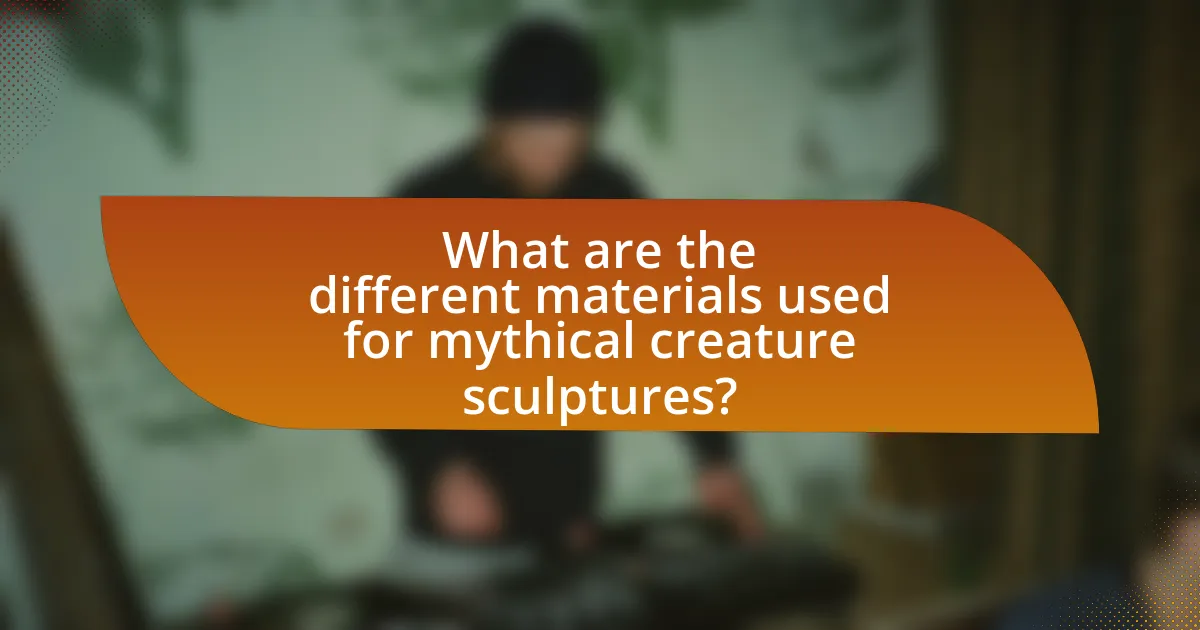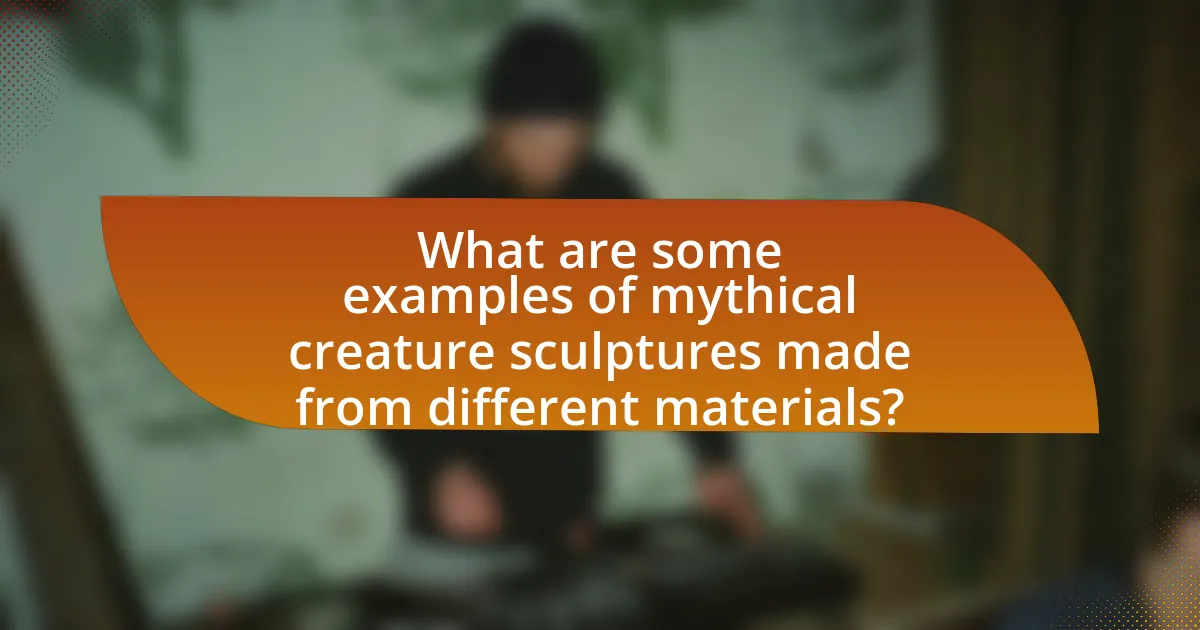The article focuses on the various materials used in the creation of mythical creature sculptures, including stone, metal, wood, clay, and resin. It examines how these materials impact artistic expression, durability, and aesthetic qualities, highlighting specific techniques associated with each medium. The discussion includes the characteristics of clay, the influence of metal on sculpture longevity, and the role of wood in traditional representations. Additionally, the article addresses practical considerations in material selection, challenges faced by sculptors, and notable examples of mythical creature sculptures across different cultures and historical periods.

What are the different materials used for mythical creature sculptures?
Various materials are used for mythical creature sculptures, including stone, metal, wood, clay, and resin. Stone, such as marble or granite, provides durability and a classic aesthetic, often seen in ancient sculptures. Metal, including bronze and aluminum, allows for intricate designs and longevity, commonly used in modern art. Wood offers a natural look and is traditionally used in various cultures for totemic representations. Clay is favored for its malleability, enabling detailed craftsmanship in smaller sculptures. Lastly, resin is popular for its versatility and ability to mimic other materials, making it suitable for both indoor and outdoor displays. Each material contributes unique qualities to the representation of mythical creatures, reflecting cultural significance and artistic intent.
How do various materials impact the artistic expression of mythical creatures?
Various materials significantly influence the artistic expression of mythical creatures by affecting texture, form, and color. For instance, clay allows for intricate detailing and smooth finishes, enabling artists to create lifelike features in sculptures of dragons or unicorns. In contrast, metal can impart a sense of strength and permanence, often used in larger installations to convey the grandeur of mythical beings. Additionally, the use of glass can introduce translucency and light effects, enhancing the ethereal quality of creatures like fairies or spirits. Historical examples include the use of bronze in ancient Greek sculptures, which provided durability and a polished aesthetic, allowing for detailed representations of mythological figures. Thus, the choice of material directly shapes the visual and emotional impact of the artistic representation of mythical creatures.
What are the characteristics of clay as a material for sculptures?
Clay is a versatile material for sculptures, characterized by its malleability, plasticity, and ability to retain fine details. Malleability allows artists to shape and manipulate clay easily, while plasticity ensures that it can be formed into intricate designs without cracking. Additionally, clay can be fired in a kiln, which hardens it and makes it durable, enabling the creation of long-lasting sculptures. The fine texture of clay also allows for detailed surface work, making it ideal for capturing the nuances of mythical creatures. Historical evidence shows that clay has been used for sculpting since ancient times, with artifacts dating back to 29,000 BCE, demonstrating its enduring appeal and effectiveness as a sculptural medium.
How does metal influence the durability and aesthetic of mythical creature sculptures?
Metal significantly enhances both the durability and aesthetic appeal of mythical creature sculptures. The inherent properties of metals, such as strength and resistance to environmental factors, ensure that sculptures can withstand the test of time, reducing the likelihood of wear and damage. For instance, bronze, a commonly used metal in sculpture, is known for its corrosion resistance and longevity, which has allowed ancient bronze sculptures to survive for centuries.
Additionally, the malleability of metals allows for intricate detailing and smooth finishes, contributing to the visual impact of the sculptures. Artists can create elaborate designs that capture the mythical essence of the creatures, enhancing their aesthetic value. The reflective quality of metals can also add depth and dimension to the sculptures, making them visually striking. Thus, the choice of metal not only ensures the longevity of mythical creature sculptures but also elevates their artistic expression.
What role does wood play in the creation of mythical creature sculptures?
Wood serves as a primary material in the creation of mythical creature sculptures due to its versatility, aesthetic appeal, and ease of manipulation. Artists utilize wood for its natural grain and texture, which can enhance the visual representation of mythical beings, making them appear more lifelike and organic. Additionally, wood is relatively lightweight compared to other materials like stone or metal, allowing for easier handling and transportation during the sculpting process. Historical evidence shows that cultures worldwide, such as the indigenous peoples of North America and various Asian traditions, have employed wood in their artistic practices, creating intricate carvings that depict mythical creatures, thereby establishing a long-standing tradition of wood as a favored medium in sculpture.
Why is the choice of material important in sculpture creation?
The choice of material is crucial in sculpture creation because it directly influences the aesthetic, durability, and expressive qualities of the artwork. Different materials, such as clay, stone, metal, or wood, possess unique properties that affect how a sculpture is formed, its texture, and how it interacts with light. For instance, marble allows for fine detail and a polished finish, making it ideal for classical sculptures, while bronze offers strength and the ability to capture intricate designs through casting. Historical examples, such as Michelangelo’s use of Carrara marble, demonstrate how material selection can enhance the visual impact and longevity of a sculpture. Thus, the choice of material is fundamental in achieving the desired artistic vision and ensuring the sculpture’s resilience over time.
How does material selection affect the final appearance of the sculpture?
Material selection significantly influences the final appearance of a sculpture by determining its texture, color, and overall aesthetic. Different materials, such as marble, bronze, or clay, each possess unique properties that affect how light interacts with the surface, the level of detail that can be achieved, and the durability of the piece. For instance, marble offers a smooth, polished finish that enhances the sculpture’s elegance, while bronze can provide a rich patina that adds depth and character. Additionally, the choice of material can impact the scale and weight of the sculpture, further influencing its visual presence. Historical examples, such as Michelangelo’s use of Carrara marble, demonstrate how material selection can elevate the artistic expression and visual impact of a sculpture.
What are the practical considerations when choosing materials for sculptures?
When choosing materials for sculptures, practical considerations include durability, weight, texture, and the intended environment. Durability is crucial as it affects the sculpture’s longevity; for instance, materials like bronze and stone withstand weathering better than clay. Weight influences the ease of transport and installation; lighter materials such as resin are preferable for large installations. Texture impacts the visual and tactile experience; materials like wood offer warmth, while metal provides a sleek finish. Additionally, the intended environment, whether indoor or outdoor, dictates material choice; for example, materials exposed to moisture must resist corrosion. These factors collectively guide artists in selecting appropriate materials for their sculptures.

What techniques are used with different materials in mythical creature sculptures?
Various techniques are employed with different materials in mythical creature sculptures, including carving, modeling, casting, and assemblage. Carving is commonly used with stone and wood, allowing artists to create intricate details and textures. Modeling techniques, often applied to clay or wax, enable sculptors to shape and refine forms before finalizing them. Casting techniques, such as lost-wax casting, are utilized with metals and resins, allowing for the reproduction of detailed designs. Assemblage involves combining various materials, such as found objects or mixed media, to create unique representations of mythical creatures. These techniques are validated by the diverse range of sculptures found in historical and contemporary art, showcasing the adaptability of materials and methods in artistic expression.
How do sculptors manipulate materials to achieve desired effects?
Sculptors manipulate materials through techniques such as carving, modeling, casting, and assembling to achieve desired effects. For instance, when working with stone, sculptors use chisels and hammers to carve intricate details, allowing for precise textures and forms. In contrast, when using clay, they can model and shape the material more fluidly, enabling the creation of dynamic poses and expressions. Additionally, casting techniques, such as bronze casting, allow for the reproduction of fine details and the creation of durable sculptures. The choice of material directly influences the final aesthetic and tactile qualities of the sculpture, as seen in the use of soft materials like wax for preliminary models versus harder materials like marble for final pieces.
What techniques are specific to working with clay in sculpture?
Techniques specific to working with clay in sculpture include hand-building, wheel-throwing, and sculpting. Hand-building involves shaping clay by hand without the use of a potter’s wheel, allowing for organic forms and intricate details. Wheel-throwing utilizes a potter’s wheel to create symmetrical shapes and is essential for producing uniform pieces. Sculpting refers to the process of adding, removing, or manipulating clay to create three-dimensional forms, often incorporating tools for detailing. These techniques are foundational in clay sculpture, enabling artists to explore various forms and textures essential for mythical creature representations.
How can metal be shaped and finished for mythical creature sculptures?
Metal can be shaped and finished for mythical creature sculptures through techniques such as forging, welding, and casting. Forging involves heating metal and shaping it with tools, allowing for detailed features and strong structures. Welding joins metal pieces together, enabling the creation of complex forms, while casting involves pouring molten metal into molds to achieve intricate designs.
These methods are supported by historical practices in metalworking, where artisans have utilized similar techniques for centuries to create both functional and artistic pieces. For instance, ancient blacksmiths used forging to create weapons and decorative items, demonstrating the effectiveness of these techniques in achieving desired shapes and finishes.
What are the challenges faced when using various materials?
The challenges faced when using various materials for mythical creature sculptures include material compatibility, durability, and aesthetic limitations. Material compatibility can lead to issues such as poor adhesion between different substances, which can compromise the structural integrity of the sculpture. Durability concerns arise from the susceptibility of certain materials to environmental factors, such as moisture or UV exposure, which can degrade the sculpture over time. Aesthetic limitations may restrict the artist’s ability to achieve desired textures or colors, impacting the overall visual appeal of the sculpture. For instance, certain plastics may not hold fine details as well as clay, affecting the final representation of the mythical creature.
What difficulties arise when sculpting with clay?
Sculpting with clay presents several difficulties, including issues with moisture control, structural integrity, and drying times. Moisture control is crucial because excessive water can lead to slumping or collapsing sculptures, while insufficient moisture can cause cracking. Structural integrity is a challenge as clay can be heavy and may require internal support to maintain shape during the sculpting process. Additionally, drying times vary based on the thickness of the clay and environmental conditions, which can complicate the timing of finishing techniques. These factors collectively impact the sculptor’s ability to achieve desired results effectively.
How can sculptors overcome issues related to metalworking?
Sculptors can overcome issues related to metalworking by utilizing advanced techniques such as welding, casting, and alloy selection. These methods allow for greater control over the properties of the metal, enabling sculptors to create intricate designs and ensure structural integrity. For instance, using MIG or TIG welding can provide strong joints that withstand stress, while casting techniques like lost-wax casting allow for detailed and complex shapes that are difficult to achieve through traditional methods. Additionally, selecting the right alloy can enhance durability and workability, as certain metals are more malleable or resistant to corrosion, which is crucial for outdoor sculptures.

What are some examples of mythical creature sculptures made from different materials?
Examples of mythical creature sculptures made from different materials include the bronze griffin sculptures found in ancient Greek architecture, the marble sculptures of mermaids in Renaissance art, and the wooden totem poles featuring mythical beings from Indigenous cultures. Bronze is often used for its durability and ability to capture intricate details, as seen in the griffins that adorned temples. Marble, favored for its elegance, showcases the delicate features of mermaids, while wood is traditionally carved into totem poles, representing various mythical creatures and their cultural significance. These examples illustrate the diverse materials employed in the creation of mythical creature sculptures across different cultures and historical periods.
How do famous artists utilize materials in their mythical creature sculptures?
Famous artists utilize a variety of materials in their mythical creature sculptures to enhance visual impact and convey thematic depth. For instance, bronze is frequently used for its durability and ability to capture intricate details, as seen in the works of artists like Auguste Rodin, who created dynamic forms that evoke movement and emotion. Additionally, contemporary artists such as Damien Hirst employ unconventional materials like glass and resin to create striking visual contrasts and explore themes of life and death, exemplified in his piece “The Physical Impossibility of Death in the Mind of Someone Living,” which features a preserved shark. These material choices not only define the aesthetic qualities of the sculptures but also serve to reinforce the narrative and conceptual intentions behind the mythical representations.
What notable sculptures exemplify the use of clay in mythical creature art?
Notable sculptures that exemplify the use of clay in mythical creature art include the “Terracotta Army” and “The Dragon of the East.” The Terracotta Army, created during the Qin Dynasty in China, features thousands of life-sized clay figures, including mythical creatures like dragons, which symbolize power and protection. The Dragon of the East, a clay sculpture from ancient Mesopotamia, represents the fusion of human and animal forms, showcasing the artistic interpretation of mythical beings. Both sculptures highlight the versatility of clay in depicting complex mythical narratives and characters.
Which iconic metal sculptures represent mythical creatures?
Iconic metal sculptures that represent mythical creatures include the “Unicorn” by David Smith and “The Dragon” by Richard Serra. The “Unicorn,” created in the mid-20th century, showcases a stylized interpretation of the legendary creature, emphasizing its grace and mystique through abstract forms. Richard Serra’s “The Dragon,” crafted from steel, embodies the fierce and powerful essence of the mythical beast, reflecting both strength and artistry. These sculptures are significant in the art world for their innovative use of metal to convey the fantastical elements of mythology.
What can be learned from analyzing different materials in sculpture?
Analyzing different materials in sculpture reveals insights into the properties and potential of each medium, influencing artistic expression and technique. For instance, materials like clay allow for intricate detailing and easy manipulation, while stone offers durability and permanence, shaping the artist’s approach to form and texture. Additionally, the choice of material can affect the final aesthetic and emotional impact of the sculpture, as seen in the contrasting warmth of wood versus the coldness of metal. Historical examples, such as Michelangelo’s use of marble, demonstrate how material selection can elevate a work’s significance and longevity in art history.
How can understanding material properties enhance a sculptor’s skills?
Understanding material properties enhances a sculptor’s skills by enabling them to select the most suitable materials for their artistic vision and techniques. Knowledge of properties such as hardness, malleability, and texture allows sculptors to manipulate materials effectively, ensuring that their intended designs are achievable. For instance, a sculptor aware of the brittleness of certain stones can avoid using them for intricate details, opting instead for more pliable materials like clay or wax for fine features. This informed choice leads to improved craftsmanship and the ability to execute complex forms, ultimately resulting in higher quality sculptures.
What best practices should sculptors follow when selecting materials?
Sculptors should prioritize durability, workability, and aesthetic qualities when selecting materials. Durability ensures that the sculpture withstands environmental factors and time, while workability allows for ease of manipulation and detail. Aesthetic qualities contribute to the visual impact of the sculpture. For instance, materials like marble and bronze are renowned for their longevity and beauty, evidenced by their use in classical sculptures that have lasted for centuries. Additionally, understanding the properties of materials, such as weight and texture, is crucial for achieving the desired artistic effect and structural integrity.


